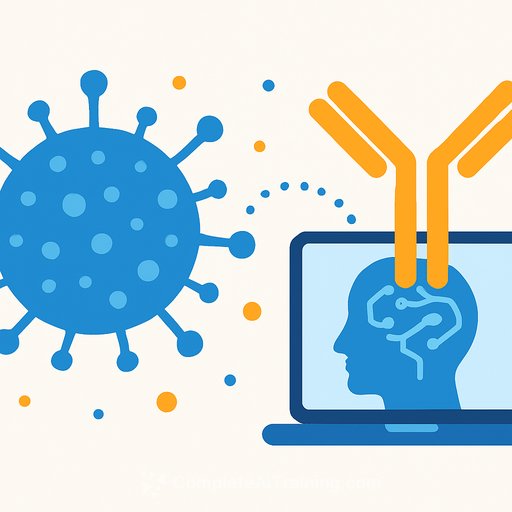AI can speed antibody design to counter novel viruses
Researchers report a practical path to faster antibody therapeutics using a protein language model called MAGE (Monoclonal Antibody Generator). In Cell (Nov. 4, 2025), a multi-institutional team led by Vanderbilt University Medical Center showed that MAGE can generate antigen-specific, paired-chain human antibodies against existing and emerging viral threats, including RSV and avian influenza.
The key result: the model produced functional antibodies that bind unique viral antigens without needing a partial antibody sequence as a starting template. For outbreak response, that removes a major bottleneck-waiting on patient samples or purified antigen protein.
What stands out for scientists and translational teams
- Generalization: Trained on antibodies to one H5N1 strain, MAGE generated binders to a related, previously unseen influenza strain.
- Paired-chain design: The model outputs heavy and light chains together, addressing the pairing constraint that often slows discovery.
- Structural confirmation: Cryo-EM mapping shows designed antibodies binding the RSV fusion (F) protein at defined epitopes.
- Template-free generation: No partial sequence seed required, reducing dependence on serology or antigen production pipelines.
- Broader use-cases: The team notes potential extension beyond infectious disease to areas like oncology, autoimmunity, and neurology.
How the approach works (high level)
Protein language models treat amino acid sequences like text. By learning statistical patterns from large antibody datasets, they can propose new sequences with desired binding properties. In this study, MAGE was trained on characterized antibodies and then tasked with generating new sequences targeting related viral antigens.
The important capability is transfer: learning from one antigen class and producing candidates for a variant or new strain. That's valuable for pathogens that drift, where speed and informed exploration of sequence space matter.
Validation details
Designed antibodies were tested against RSV and avian influenza. Binding and functional assays supported activity, and structural analysis by cryo-EM visualized antibody fragments engaging the RSV F protein, indicating epitope-specific recognition consistent with the design objective.
The work suggests an actionable workflow: computational generation, in vitro screening, and structural confirmation to select leads for preclinical development.
Why this matters for your lab
- Shorter timelines: Start design runs before patient samples or recombinant antigen are available.
- Efficient screens: Focus wet-lab effort on higher-likelihood candidates from in silico generation.
- Variant readiness: Train on known strains to seed candidates for emerging, related strains.
- Structural rigor: Pair design with cryo-EM or other structural methods to validate epitope engagement early.
- Translation path: Plan for developability assessments (stability, aggregation, immunogenicity) and manufacturing constraints from the outset.
People, funding, and scope
The study was led by Ivelin Georgiev, PhD, at Vanderbilt University Medical Center, with contributions from collaborators across the U.S., Australia, and Sweden. Perry Wasdin, PhD, served as first author, with additional Vanderbilt co-authors Alexis Janke, PhD, Toma Marinov, PhD, Gwen Jordaan, Olivia Powers, Matthew Vukovich, PhD, Clinton Holt, PhD, and Alexandra Abu-Shmais.
Support included an award of up to $30M from the Advanced Research Projects Agency for Health (ARPA-H) and NIH grants R01AI175245, R01AI152693, and 1ZIAAI005003. The authors note that the views expressed are their own and not official U.S. Government policy.
Read the paper
Cell: Generation of antigen-specific paired-chain antibodies using large language models. DOI: 10.1016/j.cell.2025.10.006
Related context on the federal program: ARPA-H
Skill up on AI methods for R&D
If you're building internal capability around sequence models, data pipelines, and validation workflows, explore practical training options: Latest AI courses.
Your membership also unlocks:






